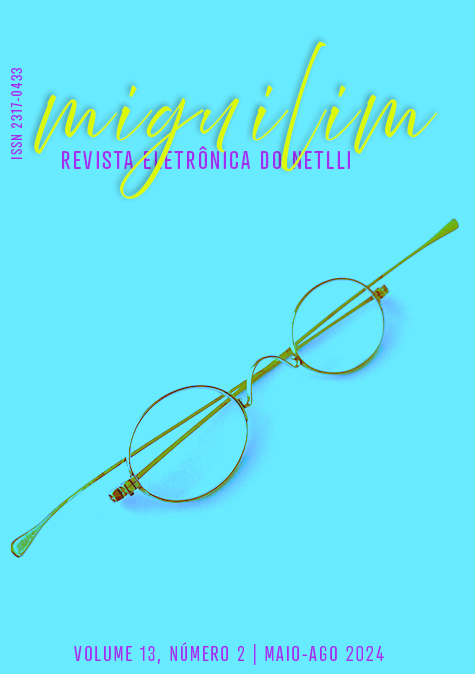Images and words: an analysis of The Handmaid's Tale's novel and series
DOI:
https://doi.org/10.47295/mgren.v13i2.1488Keywords:
Margaret Atwood, The Handmaid's Tale, Adaptation, Intermidiality, SubalternityAbstract
This research has as its object of study the work The Handmaid's Tale (1985), by Margaret Atwood, and its adaptation for television created by Bruce Miller. In this way, the work aims to discuss Hutcheon's adaptation theory (2011), studies on intermediality and cinematographic points of view, in addition to an analysis of silences and the presence of subalternity in the central character of the works. To this end, we intend to investigate, through literary analysis and intermedial analysis, how the narrator-protagonist sees her social position in the current context in which she finds herself, in addition to exposing some intertextualities present in the works. As a methodology for this work, we use a theoretical framework based on the study of literary theory, feminist literary criticism, gender studies and intermedial analyses, such as the studies of Mulvey (1975), to assist in the investigation of subalternity studies we use the contributions from Gayatri Spivak, and we used the work of Oliveira (2020) to analyze the characters’ silences. Thus, we intend to carry out, in addition to an analysis of the profile of the woman who narrates the book and series, The Handmaid's Tales, but also point out how women are subjugated by their specific role in societies, pointing out how the narrative focuses, and cinematographic films provide discussion about the positioning of women inside and outside the works.
References
ATWOOD. Margaret Eleanor. O Conto da Aia. Tradução: Ana Deiró. Rio de Janeiro: Rocco, 2017.
BARROS, Marisa Aparecida Loures de Araújo; BARROS, Marcos Paulo de Araújo; FARIA, Alexandre Graça. A representação da mulher em O Conto da Aia e em Os Testamentos: distopias do presente. IPOTESI, Juiz de Fora, v. 24, n. 2, p. 165-176, jul./dez. 2020.
BÍBLIA, A. T. “Reis”. In: BÍBLIA. Sagrada Bíblia Católica: Antigo e Novo Testamentos. Tradução: José Simão. São Paulo: Sociedade Bíblica de Aparecida, 2008.
CAVALCANTI, Ildney. Às margens das margens, o futuro do futuro: o espaço-tempo utópico em Body of Glass, de Marge Piercy. UFAL, 2007.
CHAUDHURI, Shohini. Feminist film theorists: Laura Mulvey, Kaja Silverman,
Teresa de Lauretis, Barbara Creed. Routledge, 2 Park Square, Milton Park, Abingdon, Oxon. 2006.
DA SILVA, Márcia Cristina Amaral; GASPARIN, João Luiz. A segunda revolução industrial e suas influências sobre a educação escolar brasileira. 2006.
DALRYMPLE, Theodore. Nossa cultura... ou o que restou dela. São Paulo: É Realizações, 2015.
ESCOPOFILIA. In: DICIO, Dicionário Online de Português. Porto: 7Graus, 2022. Disponível em: https://www.dicio.com.br/escopofilia/ . Acesso em: 18 ago. 2022
HANDMAIDS TALE, The. (Temporada 1) [Seriado]. Direção: Mike Barker, Kari Skogland, Reed Morano, Kate Dennis, Floria Sigsmondi. Canadá: Hulu, 2017. Streaming, cor. 10 episódios.
HUTCHEON, Linda. Uma teoria da adaptação. Tradução: André Cechinel. 2. ed. Florianópolis: Ed. da UFSC, 2013.
LORECK, Janice. Explainer: what does the ‘male gaze’ mean, and what about a female gaze? Disponível em: https://theconversation.com/explainer-what-does-the-male-gaze-mean-and-what-about-a-female-gaze-52486#:~:text=Mulvey%20argued%20that%20most%20popular,women%20for%20a%20male%20viewer Acesso em: 17 ago. 2022.
MULVEY, Laura. “Visual Pleasure and Narrative Cinema”, In. Visual and Other Pleasures, Basingstoke: Macmillan. 1975
OLIVEIRA, Daniella Moreira de. Entre a pena e a câmera: o silêncio das Capitus de Machado de Assis e Luiz Fernando Carvalho. 2020. 127 f. Dissertação (Mestrado em Letras e Linguística) – Universidade do Estado do Rio de Janeiro, Rio de Janeiro, 2020.
SPIVAK, Gayatri Chakravorty. Pode o subalterno falar? Trad. Sandra Regina Goulart Almeida; Marcos Pereira Feitosa; André Pereira Feitosa. Belo Horizonte: Editora UFMG, 2014.
Downloads
Published
Issue
Section
License
Copyright (c) 2024 Taina Dias de Castro, Natália Fontes de Oliveira

This work is licensed under a Creative Commons Attribution 4.0 International License.
The copyright belongs to the authors of the work.











